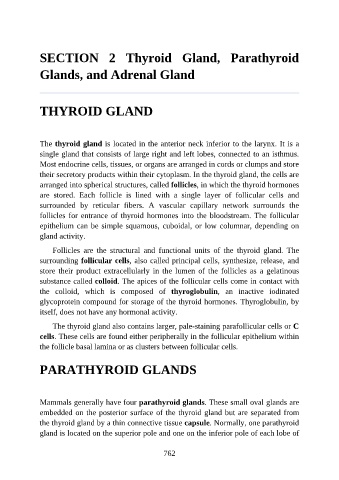Page 763 - Atlas of Histology with Functional Correlations
P. 763
SECTION 2 Thyroid Gland, Parathyroid
Glands, and Adrenal Gland
THYROID GLAND
The thyroid gland is located in the anterior neck inferior to the larynx. It is a
single gland that consists of large right and left lobes, connected to an isthmus.
Most endocrine cells, tissues, or organs are arranged in cords or clumps and store
their secretory products within their cytoplasm. In the thyroid gland, the cells are
arranged into spherical structures, called follicles, in which the thyroid hormones
are stored. Each follicle is lined with a single layer of follicular cells and
surrounded by reticular fibers. A vascular capillary network surrounds the
follicles for entrance of thyroid hormones into the bloodstream. The follicular
epithelium can be simple squamous, cuboidal, or low columnar, depending on
gland activity.
Follicles are the structural and functional units of the thyroid gland. The
surrounding follicular cells, also called principal cells, synthesize, release, and
store their product extracellularly in the lumen of the follicles as a gelatinous
substance called colloid. The apices of the follicular cells come in contact with
the colloid, which is composed of thyroglobulin, an inactive iodinated
glycoprotein compound for storage of the thyroid hormones. Thyroglobulin, by
itself, does not have any hormonal activity.
The thyroid gland also contains larger, pale-staining parafollicular cells or C
cells. These cells are found either peripherally in the follicular epithelium within
the follicle basal lamina or as clusters between follicular cells.
PARATHYROID GLANDS
Mammals generally have four parathyroid glands. These small oval glands are
embedded on the posterior surface of the thyroid gland but are separated from
the thyroid gland by a thin connective tissue capsule. Normally, one parathyroid
gland is located on the superior pole and one on the inferior pole of each lobe of
762

